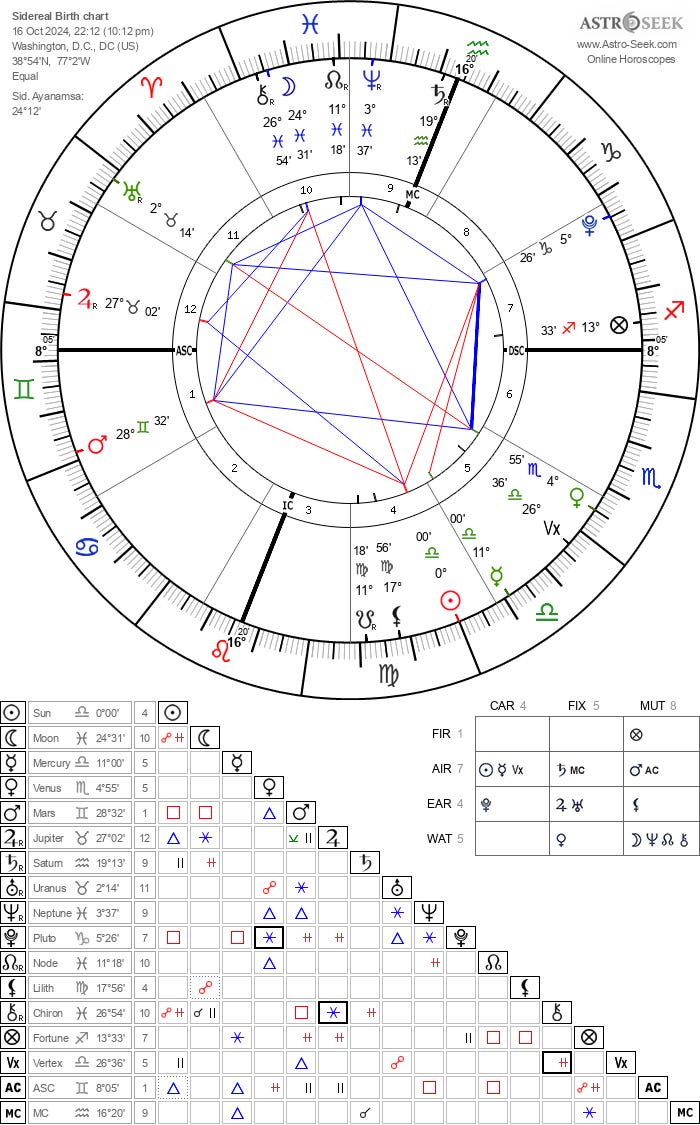One of the most prevalent things I hear people say in regard to the sidereal zodiac is that it is “astronomically accurate”. They say that it uses “the actual sky” and if your horoscope says that a planet is in a certain sign, then if you look at the sky, the planet will be in that constellation.
Unfortunately, this is false, and I find it very frustrating that people continue to make this argument when it is in fact false, and can be easily verified to be false.
In this post I will be showing a few examples so that you can see for yourself that it is not always the case that a sidereal sign aligns with its namesake constellation.
We are going to look at two points using the sidereal zodiac with the traditional Lahiri ayanamsha. As I understand it, Lahiri originally intended to put 0 degrees Libra at the star Spica, but his calculations were a little off. However, they were off by a bit less than 1 arc minute, which is 1/60th of a degree, i.e., about 0.017 degrees off. Some people use an ayanamsha called True Citra, which puts 0 degrees Libra precisely at the star Spica and not 0.017 away from it, as the traditional Lahiri ayanamsha does. In any case, I will be using the traditional Lahiri ayanamsha in this example, though the True Citra one would work as well.
So, let us look at the point 0 degrees Aries in the sidereal Lahiri zodiac. According to siderealists, if the Sun is at 0 degrees Aries in the zodiac/a horoscope, it should be at 0 degrees of the constellation Aries.
According to Jagannath Hora, a free Vedic Astrology software, 0 degrees Aries sidereal Lahiri occurred on April 13, 2024 11:25:51 EDT (4 hours west of GMT) in Washington, D.C.
Let us open the free planetarium software Stellarium and see what the sky looks like at that time and place: Washington, D.C., April 13, 2024 at 11:25:51 EDT:
The Sun is the object in the center surrounded by the four red lines. I have turned off the glare of the Sun so that it is more easily visible. You’ll notice that the sun is actually in the constellation of Pisces, so that is not what we expected. You can see for yourself that in this instance sidereal Lahiri is not “astronomically accurate”.
When does the Sun enter Aries in sidereal Lahiri? I moved forward until time until the Sun was just starting to touch the constellation boundary:
The faint red line which makes a right angle where the Sun is constitutes the constellation boundary between Pisces and Aries. Putting this date and time in Jagannath Hora, it says the Sun is at 4 degrees and 32 minutes of Aries. Again, sidereal Lahiri is not astronomically accurate.
Let us look now at 0 degrees Libra. According to Jagannath Hora, 0 degrees Libra sidereal Lahiri will occur at October 16, 2024 at 22:04:08 EDT in Washington, D.C.. Here is the sky at that moment:
The Sun again is selected in the middle of the four red lines. You can see that the Sun is clearly in the constellation of Virgo.
Let us check the positions of Mercury and Venus. Here is the same image without the Sun selected:
If, as according to siderealists, the sidereal zodiac is astronomically accurate then Mercury should in Virgo, near the end of Virgo, and Venus should be very near the end of Libra.
Where does Jagannath Hora say they are? Using sidereal Lahiri at October 16, 2024 at 22:04:08 EDT in Washington, D.C., JHora says that Mercury is at 11 degrees Libra and Venus is at 4 degrees 55 minutes of Scorpio.
If you don’t have JHora, you can confirm with astro-seek.com. Note that the time isn’t precisely the same, astro-seek doesn’t have the Sun entering 0 degrees Libra sidereal Lahiri until October 16, 22:12 EDT in Washington, D.C., 8 minutes later.
So this clearly shows that the sidereal zodiac is not astronomically accurate. We can clearly see that Mercury is in the constellation of Virgo, yet according to sidereal Lahiri it is at 11 degrees Libra.
This doesn’t in itself mean the sidereal zodiac is wrong, however, if you prefer the sidereal zodiac, astronomical accuracy should not be one of your arguments, because that argument is false.






